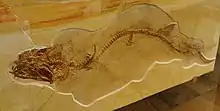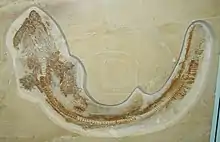Synechodontiformes
Synechodontiformes is an extinct order of prehistoric sharks, known from the Permian to the Paleogene. They are a stem-group of Neoselachii, the group that contains modern sharks and rays. They were previously considered a paraphyletic grouping, but recent studies have recovered the group as monophyletic. Members of the clade are united by two synapomorphies, "pseudopolyaulacorhize tooth root pattern present; labial root depression in basal view present".[2] The oldest possible member of the clade are teeth from the early Permian (Cisuralian) of the Ural Mountains.[3]
| Synechodontiformes Temporal range: | |
|---|---|
 | |
| Fossil of Sphenodus nitidus | |
 | |
| Paraorthacodus jurensis | |
| Scientific classification | |
| Kingdom: | Animalia |
| Phylum: | Chordata |
| Class: | Chondrichthyes |
| Superorder: | Squalomorphii |
| Order: | †Synechodontiformes Duffin & Ward, 1993[1] |
| Families | |
|
See text | |
Taxonomy
Primarily after Klug (2010)[2]
- †Orthacodontidae de Beaumont, 1960
- †Sphenodus Agassiz, 1843 Early Jurassic - Paleocene[4]
- †Occitanodus Guinot, Cappetta & Adnet, 2014, France, Early Cretaceous (Valanginian)[5]
- †Pseudonotidanidae Underwood & Ward, 2004a
- †Welcommia Cappetta, 1990
- †Pseudonotidanus Underwood & Ward, 2004a
- †Palaeospinacidae Regan, 1906
- †Antrigoulia Guinot, Cappetta, & Adnet, 2014 France, Early Cretaceous (Valanginian)[5]
- †Synechodus Woodward, 1888 Rhaetian-Paleocene[6]
- †Palidiplospinax Klug & Kriwet, 2008
- †Paraorthacodontidae Klug, 2010
- †Paraorthacodus Glikman, 1957,
- †Macrourogaleus Fowler, 1947
- Incertae sedis
- †Rhomphaiodon Duffin, 1993a
- †Mucrovenator Cuny et al., 2001
- †Safrodus Koot & Cuny, 2014[7] Early Triassic, Oman
- †Polyfaciodus Koot & Cuny, 2014 Early Triassic, Oman
References
- C. J. Duffin and D. J. Ward. 1993. The Early Jurassic Palaeospinacid sharks of Lyme Regis, southern England. Belgian Geological Survey, Professional Papers, Elasmobranches et Stratigraphie 264:53-102
- Klug, Stefanie (2010). "Monophyly, phylogeny and systematic position of the †Synechodontiformes (Chondrichthyes, Neoselachii)". Zoologica Scripta. 39 (1): 37–49. doi:10.1111/j.1463-6409.2009.00399.x. ISSN 1463-6409.
- Ivanov, Alexander (2005-08-30). "Early Permian chondrichthyans of the Middle and South Urals" (PDF). Revista Brasileira de Paleontologia. 8 (2): 127–138. doi:10.4072/rbp.2005.2.05.
- Kanno, Shiori; Nakajima, Yasuhisa; Hikida, Yoshinori; Sato, Tamaki (2017-04-01). "Sphenodus (Chondrichthyes, Neoselachii) from the Upper Cretaceous in Nakagawa Town, Hokkaido, Japan". Paleontological Research. 21 (2): 122. doi:10.2517/2016PR009. ISSN 1342-8144.
- Guinot, Guillaume; Cappetta, Henri; Adnet, Sylvain (March 2014). "A rare elasmobranch assemblage from the Valanginian (Lower Cretaceous) of southern France". Cretaceous Research. 48: 54–84. doi:10.1016/j.cretres.2013.11.014.
- Batchelor, Trevor J.; Duffin, Christopher J. (August 2020). "First description of sharks' teeth from the Ferruginous Sands Formation (Aptian, Early Cretaceous) of the Isle of Wight". Proceedings of the Geologists' Association. 131 (3–4): 353–359. doi:10.1016/j.pgeola.2019.06.004.
- Koot, Martha B.; Cuny, Gilles; Orchard, Michael J.; Richoz, Sylvain; Hart, Malcolm B.; Twitchett, Richard J. (2015-10-03). "New hybodontiform and neoselachian sharks from the Lower Triassic of Oman". Journal of Systematic Palaeontology. 13 (10): 891–917. doi:10.1080/14772019.2014.963179. ISSN 1477-2019.
External links
 Data related to Synechodontiformes at Wikispecies
Data related to Synechodontiformes at Wikispecies Media related to Synechodontiformes at Wikimedia Commons
Media related to Synechodontiformes at Wikimedia Commons
This article is issued from Wikipedia. The text is licensed under Creative Commons - Attribution - Sharealike. Additional terms may apply for the media files.